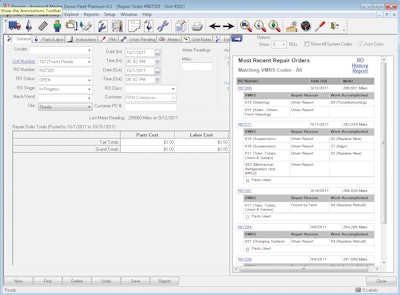
Drilling down
Fleets still not convinced that it’s time to invest in shop technology might consider all the positives that come out of doing so. For a fleet manager, the immediate benefits are obvious, says Dave Costantino, Commercial Vehicle Group director for Mitchell 1.
 Arsenault Associates says Dossier Version 6.1, the latest edition of its fleet asset maintenance management software, offers enhancements at both the individual user and enterprise levels, including Arsenault’s Instant Recall repair histories.
Arsenault Associates says Dossier Version 6.1, the latest edition of its fleet asset maintenance management software, offers enhancements at both the individual user and enterprise levels, including Arsenault’s Instant Recall repair histories.“They rapidly gain a bird’s eye view of service activity on the fleet for which he’s responsible,” Costantino says. “He can also see his parts inventory and inventory turns.” Standard repair times provide the manager with the ability to see how well mechanics are performing, and they provide more accurate and consistent estimates, he says.
Handheld devices can collect data quickly and speed up the process of getting a truck diagnosed and a cost estimate to the customer as efficiently as possible, says Bob Merrill, operations analyst with W.W. Williams, a member of the Wheel Time Network. “At our shops, we are using iPads and tablets,” Merrill says.
Maintenance software also can be used in conjunction with other fleet management technologies. “Most telematics systems integrate with popular maintenance systems to automate the creation of work orders and streamline the process from start to finish,” says Andrew Johnson, marketing director for Zonar.
No need to worry about computer and device durability, says Monica Truelsch, director of marketing for TMW Systems. “The downside is that hardened shop computers for rough industrial environments might come at a significantly higher cost than run-of-the-mill office desktops or laptops,” Truelsch says.
Meanwhile, the days of technicians flipping through hundreds or thousands of pages in shop manuals to find service information will be over forever as PCs put information at their fingertips by entering the year, make and model of the truck.
Many shop management systems also offer a parts inventory module that provides an accurate running inventory. As parts are placed on work orders, the inventory is reduced automatically, and as stock orders arrive from the parts warehouse, the inventory is incremented as the parts are checked in, saving time and increasing accuracy for parts management.
Bedaris says the biggest advantage fleets find after they’ve implemented shop software is in how warranty issues are handled. “In our experience, warranty is where fleets get their ROI,” he says.
Another benefit is the ability to determine proper cost per mile and failure analysis at the component level. “What that does is drill down into the spec rationalization aspect and availability analysis, and it really tells you if you’re spec’ing and building the right vehicle to do your work today and if you have the right platform for the future,” Bedaris says.
The biggest asset to a technician is instant knowledge of the maintenance history of the unit in his bay. “Knowledge of previous maintenance eliminates repetitive repairs, identifies that a repair activity may be covered by warranty, reduces cost and improves uptime of the unit,” says Dave Reed, fleet management consultant for Arsenault.
Management also gets additional windfalls since maintenance software can capture the frequency of repairs and cost by make and model – and even components. “If the system is properly set up to capture driver assignment, it will also be simple to identify where driver improvement is needed,” says Reed.
The bleed-over benefits also apply to other fleet management aspects – including Compliance Safety Accountability oversight. A gap in maintenance data can spill over to increased CSA scores and a potential U.S. Department of Transportation intervention, says Randy Thome, director of technology services for J.J. Keller & Associates. At the same time, shop information technology also results in fewer dispatch delays due to more accurate repair times.
“People always say, ‘Keep it simple,’ but there’s really nothing more simple than using maintenance software,” Simmons says.











